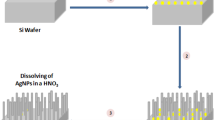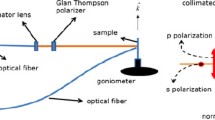Abstract
Future electronics will be made of silicon nanostructures (SiNs). Mechanical, electrical, and optical characteristics, as well as litho resistivity and thermoelectricity, making them remarkable multi-functional materials. SiNs are used in nanoelectronics, nanoresonators, light-emitting diodes, nanosensors, and thermoelectric energy scavengers, to name a few. Mechanical properties of SiNs, which are expected to differ from those of bulk SiNs, are crucial to the performance and dependability of these nanoelectronics. The metal-aided etching procedure was employed to make the SiNs used in this investigation. This SEM picture of as-grown SiNs displays its structure and demonstrates that the Ns have widths of less than 100 nm. The X-ray diffraction pattern of SiNs reveals the Ns' single-crystalline structure. When polarization-resolved reflections were used on these nanowire arrays, the reflection properties of s- and p-polarized laser beams were found to differ significantly. The findings of this study can be used to a wide range of optical devices that utilise SiNWs, including photodetectors and solar cells. Furthermore, it has the potential to be beneficial in medical imaging.
Similar content being viewed by others
Data Availability
No supplementary materials.
References
Campanelli RB, dos Santos MVP, da Cruz ASE, Pirota KR, Béron F (2021) Highly doped si single crystal nanowires via metallic flux nanonucleation. IEEE Trans Nanotechnol 20:739–743. https://doi.org/10.1109/TNANO.2021.3112905
Dwivedi P, Dhanekar S, Das S (2021) Near room temperature sensing by In2O3 decorated silicon nanowires for sensitive detection of ethanol. IEEE Sensors J 21(6):7275–7282. https://doi.org/10.1109/JSEN.2020.3046490
Yu Y, Chen S, Hu Q, Solomon P, Zhang Z (2021) Ultra-low noise schottky junction tri-gate silicon nanowire FET on bonded silicon-on-insulator substrate. IEEE Electron Device Lett 42(4):469–472. https://doi.org/10.1109/LED.2021.3057285
Salimi Kuchi P, Roshan H and Sheikhi MH (2020) A novel room temperature ethanol sensor based on PbS:SnS2 nanocomposite with enhanced ethanol sensing properties. J Alloys Compd 816:152666
Lai J, Su Y, Bu J, Li B, Li B, Zhang G (2020) Study on degradation mechanisms of thermal conductivity for confined nanochannel in gate-all-around silicon nanowire field-effect transistors. IEEE Trans Electron Devices 67(10):4060–4066. https://doi.org/10.1109/TED.2020.3014557
Nama Manjunatha K, Salaoru I, Milne WI, Paul S (2020) Comparative study of silicon nanowires grown from Ga, In, Sn, and Bi for energy harvesting. IEEE J Photovoltaics 10(6):1667–1674. https://doi.org/10.1109/JPHOTOV.2020.3012628
Raine M et al (2019) SET sensitivity of trigate silicon nanowire field-effect transistors. IEEE Trans Nucl Sci 66(1):352–358. https://doi.org/10.1109/TNS.2018.2879194
Chen G et al (2019) Selective-assembling hybrid Porphyrin-Silicon Nanowire Field-Effect Transistor (PSNFET) for photonic sensor. IEEE Electron Device Lett 40(5):812–814. https://doi.org/10.1109/LED.2019.2903862
Yuan Z et al (2019) Sandwich-like composites of double-layer Co3O4 and reduced graphene oxide and their sensing properties to volatile organic compounds. J Alloys Compd 793:24–30
Hsin C, Wu M, Wang W (2019) Thermoelectric devices by half-millimeter-long silicon nanowires arrays. IEEE Trans Nanotechnol 18:921–924. https://doi.org/10.1109/TNANO.2019.2938624
Meng F et al (2019) Synthesis of Au nanoparticle-modified spindle shaped α-Fe2O3 nanorods and their gas sensing properties to Nbutanol. IEEE Trans Nanotechnol 18:911–920. https://doi.org/10.1109/TNANO.2019.2933569
Bhowmik B, Dutta K, Bhattacharyya P (2019) An efficient room temperature ethanol sensor device based on p-n homojunction of TiO2 nanostructures. IEEE Trans Electron Devices 66(2):1063–1068
Klüpfel FJ (2019) Influence of sacrificial layer germanium content on stacked-nanowire FET performance. IEEE Access 7:85855–85859. https://doi.org/10.1109/ACCESS.2019.2925201
Mohamed S, Shahada L, Swillam M (2018) Vertical silicon nanowires based directional coupler optical router. IEEE Photon Technol Lett 30(9):789–792. https://doi.org/10.1109/LPT.2018.2815040
Almoallem YD, Moghimi MJ, Jiang H (2018) Conformal antireflective surface formed onto 3-D silicon structure. J Microelectromech Syst 27(3):380–382. https://doi.org/10.1109/JMEMS.2018.2825649
Hayati L, Zare S, Lombardi F, Vittoria C (2018) Ferromagnetic resonance of Y3Fe5O12 nanowires. IEEE Magn Lett 9:1–4. https://doi.org/10.1109/LMAG.2018.2870055 (4106204)
Carnio BN, Elezzabi AY (2018) Second harmonic generation in CdSiP2 nanowires in the optical frequency regime. IEEE Photon Technol Lett 30(15):1408–1411. https://doi.org/10.1109/LPT.2018.2850519
Pregl S, Baraban L, Sessi V, Mikolajick T, Weber WM, Cuniberti G (2018) Signal and noise of Schottky-Junction parallel silicon nanowire transducers for biochemical sensing. IEEE Sensors J 18(3):967–975. https://doi.org/10.1109/JSEN.2017.2778188
Lai RA, Hymel TM, Narasimhan VK, Cui Y (2016) Schottky barrier catalysis mechanism in metal-assisted chemical etching of silicon. ACS Appl Mater Interfaces 8(14):8875–8879
Balderas-Valaez RF, Agarwaland V, Pacholski C (2016) Fabrication of porous silicon based optical sensors using metal assisted chemical etching. RSC Adv 6:21430
Kong L, Dasgupta B, Ren Yi, Mohseni PK, Hong M, Li X (2016) Wai Kin Chim & Sing Yang Chiam, evidences for redox reaction driven charge transfer and mass transport in metal-assisted chemical etching of silicon. Sci Rep 6:36582
Hashiguchi K, Suzuki K, Hiroshima H, Naitoh Y, Suga H (2018) Pt nanogap electrode fabrication by two-layer Lift-Off UV-NIL and nanowire breakdown. IEEE Trans Nanotechnol 17(6):1094–1097. https://doi.org/10.1109/TNANO.2018.2844125
Kamišalić A, Fister I, Turkanović M, Karakatič S (2018) Sensors and functionalities of non-invasive wrist-wearable devices: a review. Sensors 18(6):1714
Li M, Fan J, Xu X, Huang R (2017) Investigation on electrostatic discharge robustness of gate-all-around silicon nanowire transistors combined with thermal analysis. IEEE Electron Device Lett 38(12):1653–1656. https://doi.org/10.1109/LED.2017.2768484
Hazari A et al (2017) $1.3~\mu $ m Optical Interconnect on Silicon: A Monolithic III-Nitride Nanowire Photonic Integrated Circuit. IEEE J Quantum Electron 53(4):1–9. https://doi.org/10.1109/JQE.2017.2708526 (6300109)
Sohi PA, Kahrizi M (2017) Formation mechanism of silicon nanowires using chemical/electrochemical process. IEEE Trans Nanotechnol 16(3):507–513. https://doi.org/10.1109/TNANO.2017.2694428
Tanaka H, Suda J, Kimoto T (2017) Analysis of high-field hole transport in germanium and silicon nanowires based on boltzmann’s transport equation. IEEE Trans Nanotechnol 16(1):118–125. https://doi.org/10.1109/TNANO.2016.2635110
Zhang S, Lou L, Gu YA (2017) Development of silicon nanowire-based nems absolute pressure sensor through surface micromachining. IEEE Electron Device Lett 38(5):653–656. https://doi.org/10.1109/LED.2017.2682500
Prakash MD, Nelam BG, Ahmadsaidulu S, Navaneetha A, Panigrahy AK (2021) Performance analysis of ion-sensitive field effect transistor with various oxide materials for biomedical applications. Silicon. https://doi.org/10.1007/s12633-021-01413-9
Prakash MD, Krsihna BV, Satyanarayana BVV, Vignesh NA, Panigrahy AK, Ahmadsaidulu S (2021) A study of an ultrasensitive label free silicon nanowire FET biosensor for cardiac troponin I detection. SILICON. https://doi.org/10.1007/s12633-021-01352-5
Meriga C, Ponnuri RT, Satyanarayana BVV, Gudivada AAK, Panigrahy AK and Prakash MD (2021) A novel teeth junction less gate all around FET for improving electrical characteristics. Silicon. https://doi.org/10.1007/s12633-021-00983-y
Sreenivasulu VB, Narendar V (2021) Junctionless gate-all-around nanowire FET with asymmetric spacer for continued scaling. Silicon. https://doi.org/10.1007/s12633-021-01471-z
Acknowledgements
The authors are thankful to Excel Engineering College, Namakkal, India for their cooperation and support during this research work.
Author information
Authors and Affiliations
Contributions
A Mohamedyaseen, P Suresh Kumar: Conceptualization; A Mohamedyaseen, P Suresh Kumar: investigation; A Mohamedyaseen, P Suresh Kumar: resources; A Mohamedyaseen, P Suresh Kumar: data curation; A Mohamedyaseen, P Suresh Kumar: writing—original draft preparation; A Mohamedyaseen, P Suresh Kumar: writing—review and editing; A Mohamedyaseen, P Suresh Kumar: visualization; P Suresh Kumar: supervision.
Corresponding author
Ethics declarations
Consent to Participate
Yes
Consent for Publication
Author(s): A Mohamedyaseen
Conflict of Interest
The authors declare that they have no conflict of interest.
Human and Animal Rights and Informed Consent
This article does not contain any studies with human or animal subjects.
Additional information
Publisher's Note
Springer Nature remains neutral with regard to jurisdictional claims in published maps and institutional affiliations.
Rights and permissions
About this article
Cite this article
Mohamedyaseen, A., Kumar, P.S. The Fabrication of High-Anisotropy Silicon Nanowires Based on MACE Method for Photonic Sensor. Silicon 14, 11417–11427 (2022). https://doi.org/10.1007/s12633-022-01751-2
Received:
Accepted:
Published:
Issue Date:
DOI: https://doi.org/10.1007/s12633-022-01751-2




